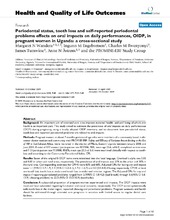| dc.contributor.author | Wandera, Margaret Nekesa | en_US |
| dc.contributor.author | Engebretsen, Ingunn Marie S. | en_US |
| dc.contributor.author | Rwenyonyi, Charles M. | en_US |
| dc.contributor.author | Tumwine, James K. | en_US |
| dc.contributor.author | Åstrøm, Anne Nordrehaug | en_US |
| dc.date.accessioned | 2010-01-14T08:42:09Z | |
| dc.date.available | 2010-01-14T08:42:09Z | |
| dc.date.issued | 2009-10-14 | eng |
| dc.Published | Health and Quality of Life Outcomes 7(89) | en |
| dc.identifier.issn | 1477-7525 | |
| dc.identifier.uri | https://hdl.handle.net/1956/3729 | |
| dc.description.abstract | Background: An important aim of antenatal care is to improve maternal health- and well being of which oral health is an important part. This study aimed to estimate the prevalence of oral impacts on daily performances (OIDP) during pregnancy, using a locally adapted OIDP inventory, and to document how periodontal status, tooth-loss and reported periodontal problems are related to oral impacts. Methods: Pregnant women at about 7 months gestational age who were members of a community based multicenter cluster randomized community trial: PROMISE EBF: Safety and Efficacy of Exclusive Breast feeding in the Era of HIV in Sub-Saharan Africa, were recruited in the district of Mbale, Eastern Uganda between January 2006 and June 2008. A total of 877 women (participation rate 877/886, 98%, mean age 25.6, sd 6.4) completed an interview and 713 (participation rate 713/886, 80.6%, mean age 25.5 sd 6.6) were examined clinically with respect to toothloss and according to the Community Periodontal Index, CPI. Results: Seven of the original 8 OIDP items were translated into the local language. Cronbach's alpha was 0.85 and 0.80 in urban and rural areas, respectively. The prevalence of oral impacts was 25% in the urban and 30% in the rural area. Corresponding estimates for CPI>0 were 63% and 68%. Adjusted ORs for having any oral impact were 1.1 (95% CI 0.7-1.7), 1.9 (95% CI 1.2-3.1), 1.7 (1.1-2.7) and 2.0 (0.9-4.4) if having respectively, CPI>0, at least one tooth lost, tooth loss in molars and tooth loss in molar-and anterior regions. The Adjusted ORs for any oral impact if reporting periodontal problems ranged from 2.7(95% CI 1.8-4.2) (bad breath) through 8.6(95% CI 5.6- 12.9) (chewing problem) to 22.3 (95% CI 13.3-35.9) (toothache). Conclusion: A substantial proportion of pregnant women experienced oral impacts. The OIDP impacts were most and least substantial regarding functional- and social concerns, respectively. The OIDP varied systematically with tooth loss in the molar region, reported chewing-and periodontal problems. Pregnant women's oral health should be addressed through antenatal care programs in societies with limited access to regular dental care facilities. | en_US |
| dc.language.iso | eng | eng |
| dc.publisher | BioMed Central | eng |
| dc.rights | Attribution CC BY | eng |
| dc.rights.uri | http://creativecommons.org/licenses/by/2.0 | eng |
| dc.title | Periodontal status, tooth loss and self-reported periodontal problems effects on oral impacts on daily performances, OIDP, in pregnant women in Uganda: a cross-sectional study | en_US |
| dc.type | Peer reviewed | |
| dc.type | Journal article | |
| dc.description.version | publishedVersion | en_US |
| dc.rights.holder | Wandera et al; licensee BioMed Central Ltd. | |
| dc.identifier.doi | https://doi.org/10.1186/1477-7525-7-89 | |
| dc.identifier.cristin | 346355 | |
| dc.subject.nsi | VDP::Medisinske Fag: 700::Klinisk odontologiske fag: 830 | nob |

